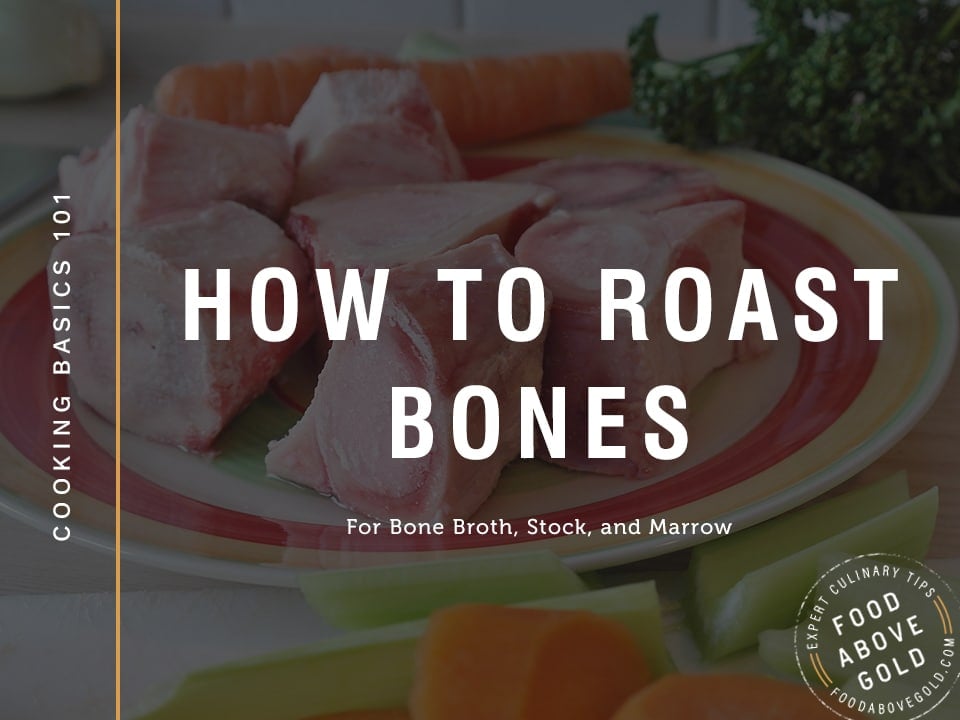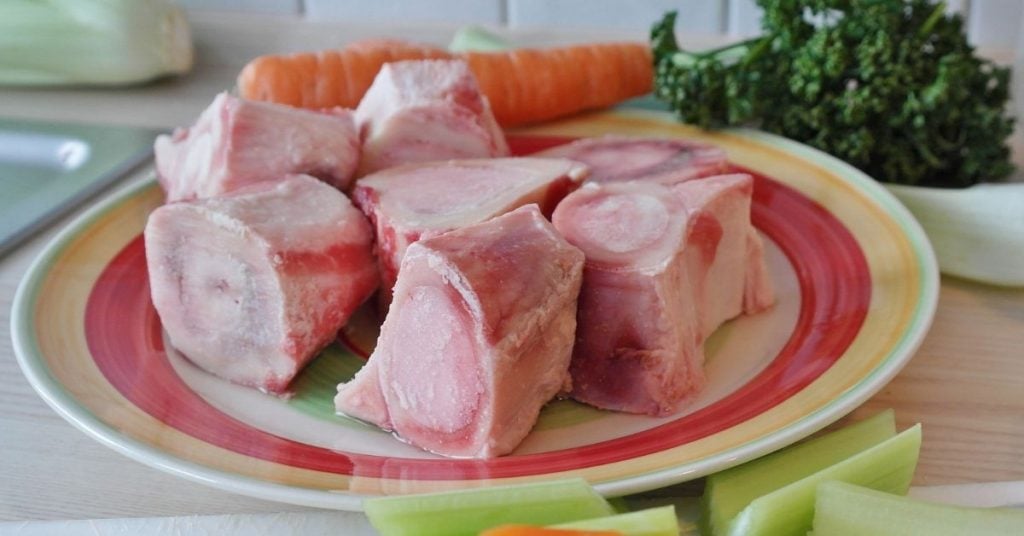Whether you’re making a bone broth recipe, homemade stock, or want to try eating bone marrow, properly roasted bones are important for quality. Find out the benefits of roasting bones and how to roast bones for each type of use!

This post was updated on July 1, 2019 with new content for your enjoyment.
As we begin looking at the different building blocks of sauces, let’s focus on how to roast bones. This is great if you want to take up drinking bone broth, want to make a thick and rich brown stock, or you want to start eating health-promoting marrow.
What Are The Benefits of Roasting Bones?
There are many different reasons for roasting bones, both for your stock/broth and for your health.
- Stock and/or Bone Broth Benefits
- Flavor. Roasting your bones helps to create a deeper, fuller, and richer flavor from the caramelizing of the meat and marrow.
- Gelatin. The naturally existing collagen and connective tissue in the bones helps make your stock thick and gelatinous. When you add acid to your bones (usually from brushing them with tomato paste) it helps to draw out even more of the collagen to make an even thicker stock. This is great if you plan to reduce it into a demi-glace.
- Nutrients. As the bones are boiled into the bone broth or stock, it melts in the marrow; this may release many of the marrow's health benefits (although this is up for debate as there isn't a lot of scientific backing for it. If you would like to read more, check out this article from NPR).
- Health
- The marrow in bones is not just for food snobs or your dogs; it is packed with lots of quality vitamins and minerals, stem cells, and amino acids.
- Marrow is believed to reduce inflammation (especially in the GI tract), promote self-healing, improved brain function, healthy skin, and help prevent and/or heal cancer.
- Marrow is high in healthy fats and is good for promoting a longer lasting "full" feeling after eating.
Not all bones are equal! Knowing how to roast bones properly can maximize the health benefits. It's also important to choose bones that have a higher amount of marrow and are from animals that are raised humanely and organically.

How To Roast Bones for Bone Broth or Stock
Properly roasted bones give additional flavor and body to your bone broth or stock. If I could give you my number one trick for success, it is this!
- Preheat your oven to 425°F.
- Place bones in a heavy bottomed deep roasting pan, or on a parchment paper lined baking sheet and roast in the oven for about 30 minutes. You want the bones to be a darker color but not burn any residual meat.
- If desired: remove the bones from the oven, brush them with tomato paste and return them to the oven for an additional 10 minutes.*
*The acid in the tomato paste helps dissolve the connective tissue in the bones. It also adds a little extra flavor.
How to Roast Bones for Marrow
When it comes to eating marrow, the best bones for the job come from beef or veal. You can get marrow bones pretty easily from your butcher (and usually very cheap) and they can leave them whole or cut them in half. Either will work wonderfully, but if you get the split bones your cooking time may vary depending on how thick they are. However, this does make it easier to get the marrow out
You want your marrow to be loose and give a little, but make sure to remove it from the oven before it begins to cook away.
- Preheat oven to 450 degrees.
- Place your bones vertically on a parchment paper lined sheet pan and sprinkle them lightly with salt.
- Place in the oven and roast for 15 minutes.
- Remove the bones from the oven and scoop out the marrow using a spoon or butter knife.
- Serve as desired: on grilled bread, in a compound butter, with garlic and caramelized onions, with parsley and lemon, straight out of the bone - whatever strikes your fancy.
Practice Makes Perfect
Now that you know how to roast bones, put it to good use. Here are some recipes I recommend trying:
- Rich & Flavorful Brown Stock (This works for beef stock, chicken broth, etc...)
- Espagnole Mother Sauce
Thanks for stopping by!
Happy Cooking! 🙂



Ana says
Hi! Do you recommend adding ACV to the bones after roasting the bones?
Mackenzie Ryan says
Hi Ana!
Honestly, I don't. Not because it's a bad choice, but because it redoes the work you've already done. Apple cider vinegar is used to break down the connective tissues in the bones, similar to the acid in the tomato paste. You don't really need both options, just one to help the bones along. If you choose ACV instead, you can brush it onto the bones just like tomato paste.
I hope that that helps. Happy Cooking! 🙂
May says
Once you roast the bones can the fat from the roasted bones be used for cooking? How quickly does it expire? And is there any nutrition in the fat that came from roasting the bones?
Mackenzie Ryan says
Hi May!
Yes, you can use the fat from the bones if you like. If you can, strain out any small pieces with a fine mesh strainer lined with cheesecloth. The more you can you remove, the longer the fat lasts. With the pieces left in it, keep it in the refrigerator up to a week in an airtight container. Without any pieces, it will last indefinitely in the fridge.
As for the nutritional benefits, no extras, just a fantastic flavor.
I hope that helps,
Mackenzie
joe says
I just came across this and found out things I didn't yet know! Thank you! The tomato paste is a new one for me. So, do you baste the bones with the tomato paste before roasting? Once you put the bones in water to simmer, won't that wash off the tomato paste or does that not matter? I currently use ACV and have been happy with the deep flavor I get (I use a slow cooker for 24-30 hours) ,but I really like learning new and improved ways to get the most flavor and health benefits!
Mackenzie Ryan says
Hi Joe!
Yes, you baste the bones before roasting. The acid in the ACV does the same thing as the tomato paste as far as how it encourages the browning of the bones. The tomato paste will give it a slightly deeper flavor than the apple cider vinegar which is a little brighter. But it all really depends on what you're going for. It's not a big deal that the paste washes into the water, it will flavor the broth a little bit more.
Hope that helps! Happy Cooking! 🙂
Mackenzie
Lu Villasenor says
Great Information this definitely helps motivate Me to finally start cooking w/broth🙂
Mackenzie Ryan says
I love hearing that, Lu. Please come back and let me know how it ends up!
Happy Cooking!
Mackenzie
Michelle Moore says
I had read that you should blanch them before roasting them to make a stock. Curious if this is correct and also I wanted to know if I should soak bones in ACV before roasting??
Mackenzie Ryan says
Hi Michelle! Thanks so much for taking the time to stop by and ask your question. Questions like these are my favorite.
As for blanching, that isn't necessary as long as you skim the stuff that rises to the top away. The idea behind blanching is to remove "impurities", but those will float to the surface regardless, so it mostly just creates an extra step. In fact, the extra moisture that comes from blanching the bones inhibits browning during roasting and lead to less flavor. I have an extremely detailed five part series on making an excellent stock that goes into more detail about that. (You can find part one HERE.)
As for the apple cider vinegar soak, it depends on what your purpose for it is. If your purpose it to clean the bones, it isn't necessary because those same impurities rise to the top and get skimmed out. If, however, the purpose is to create an acid for intensifying flavor, apple cider vinegar makes a fun alternative to tomato paste. It won't be as potent as tomato paste, or create the same depth of flavor, but can be really nice is a lighter stock or broth.
I hope this answers your questions. Please let me know if you have more. 🙂
Happy Cooking!
Mackenzie
Merry says
Should you wash/parboil bones before or after roasting?
Thank you in advance!
Mackenzie Ryan says
Hi Merry,
If you are roasting the bones for marrow, you can give them a quick scrub before roasting to remove any potential issues. If you are using them for stock or broth, no washing is necessary as any impurities will rise to the surface to be skimmed off during the simmering. I wouldn't scrub them too hard though because some of the goodies that impart flavor are on the bone before roasting. Just make sure to pat them dry before roasting. I hope that helps. Happy cooking!
Mackenzie